Physical Address
1625 South 3rd Street
Louisville, KY 40208
The Plecostomus catfish, sometimes known as the Pleco for short, is a common name for a group of catfishes’ members of the Loricariidae family. It is estimated that there are more than 150 distinct Pleco types, varying in size from tiny to large, calm to violent.
They will not be much action during the daylight hours. In the daylight, Plecos may be timid and will often be seen hidden behind the plants and caves in the tank, rather than swimming about freely.
Plecos are remarkable due to their mouthparts, which resemble a suction cup and enable them to stick to smooth surfaces in the aquarium.
Today, we’ll look at 15 different species of freshwater Pleco fishes that you can add to your aquarium.
The Clown Pleco (Panaqolus maccus) is a peaceful freshwater fish native to South America. Clown Plecos are a very low-maintenance and uncomplicated species that is regarded to be a suitable beginner-friendly fish.
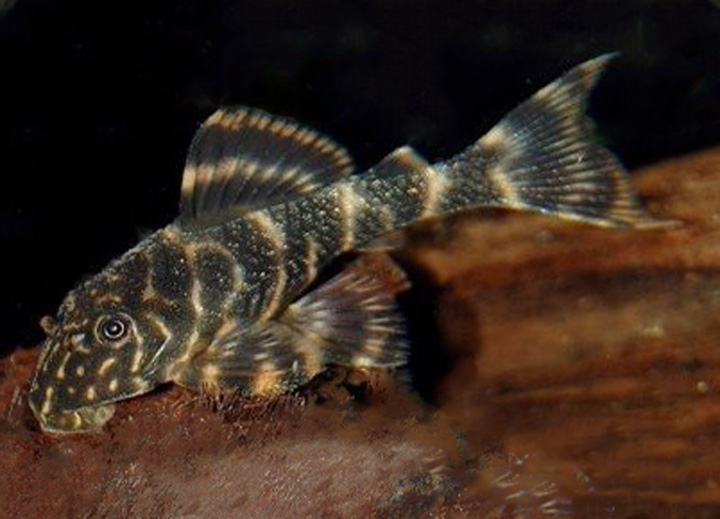
This bottom-dweller, sometimes known as the ringlet Pleco, is typically black in appearance. However, small yellow or orange stripes provide an attractive contrast to the black tone. The lines have extended to their massive dorsal and caudal fins also.
Temperatures between 73 and 82 °F and pH balance range between 6.8 and 7.6 are ideal for them. The necessary hardness of the water is 10 dGH. A minimum tank size of 20 gallons is suggested for Clown Plecos. When properly cared for, the regular Clown Pleco lives between 10 and 12 years. The typical clown Pleco is around 3.5 inches in length.
They are Omnivorous. This kind of Pleco is a massive admirer of algae. They thrive in tanks with driftwood as a centerpiece. Driftwood serves as a hideout, a playground, as well as a source of food for these creatures.
Clown Plecos have a wide range of tank mates that get along well with them. Some of them are Ember tetra, Cory catfish, Dwarf gourami, small types of Rasboras, and Minnows. Breeding the clown plecos in a home environment might be difficult due to the species’ spawning triggers. Ich Disease may affect Clown Plecos.
The Bristlenose Pleco (Ancistrus sp) is a wonderfully exciting and enjoyable creature fairly popular in freshwater aquariums. The bristlenose plecois native to South American streams and rivers.
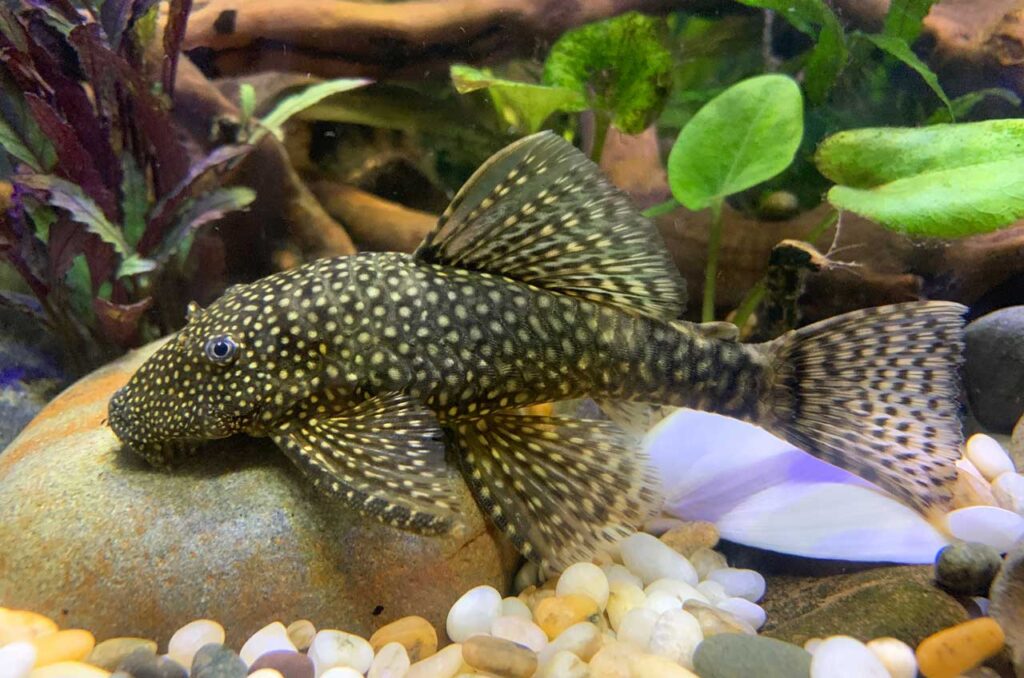
Bristlenose Plecos have bristly heads. Their heads are larger than those of the majority of other Pleco types. Although the Birstlenose Pleco comes in various colors, the majority will have a black base color coated in a pattern of lighter spots. Bristlenoses are nocturnal, peaceful, and gentle fish.
These algae-eating bottom-dwelling fish are well-known for their voracious appetites. They will scour the aquarium for food. Nonetheless, aquarists want to supplement their diet with algal wafers, sunken food scraps, and the sometimes protein-rich live feed.
Bristlenose catfish are one of the tiniest aquarium catfish, reaching an average size of 3-5 inches. Life expectancy is more than five years. For Bristlenoses, the water temperature should be between 15 to 27 °C (60 to 80 °F), the hardness should be between 20 to 25, and the pH should be between 6.5 to 7.5.
A minimum of 25 gallons is required depending on the other fish housed with the Bristlenose. Any calm fish makes an excellent tank companion for Bristlenose Plecos. They do well with Neon Tetras, Platy fish, Guppies, and other community fish. It is not difficult to breed Bristlenose Plecos. Ich, Hexamita (Hole-in-the-Head), body fungus, Pop Eye, Dropsy, and Fin Rot are the most common infections in Plecos. Medications containing salt should be avoided.
The Zebra Pleco is an easy-to-care-for type of freshwater aquarium fish that is gorgeous and unusual in appearance. It is one of the fascinating suckermouth beauties, and its distinctive white and black stripes make it a highly sought-after fish among all types of aquarists and fish keepers.
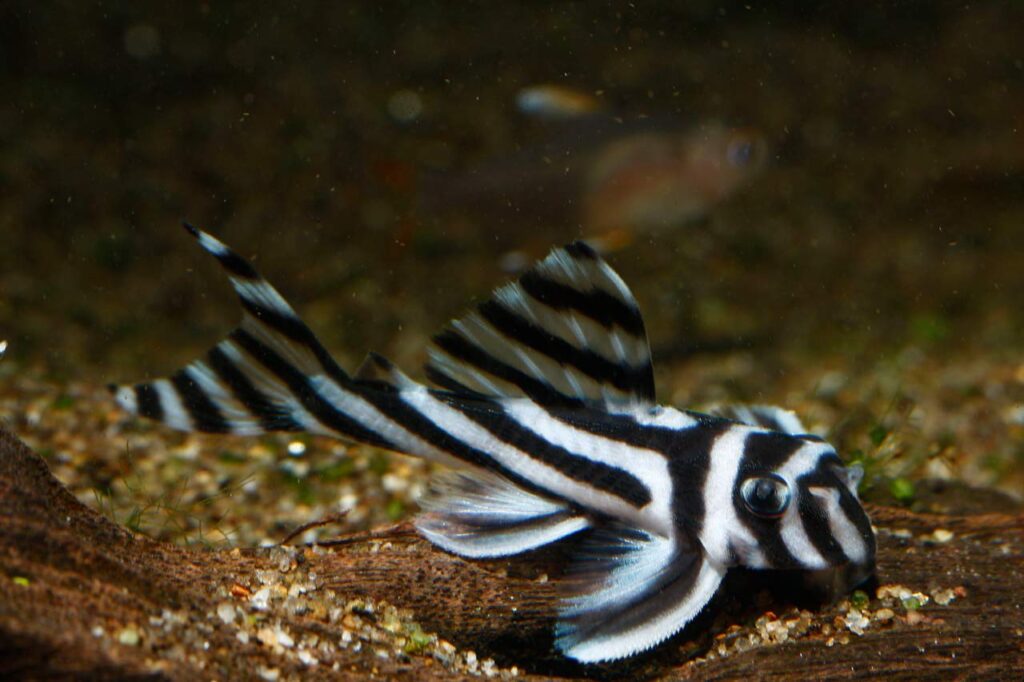
This fish is in great demand and since it is endangered in its native Brazil. Zebra Plecos are nocturnal fish that are quiet, gentle, and non-aggressive. The typical adult Zebra Pleco is 3 to 4 inches in length. A Zebra Pleco has a very long life span. Numerous Zebra Plecos raised in tanks have been observed to survive between ten and fifteen years.
A tank with a minimum capacity of 30 gallons is necessary for four to five Zebra Plecos. Zebra Plecos demand high currents in their water, which means aquarists need to purchase a robust water filter. Additionally, the water should be suitably aerated since the fish prefers a high oxygen saturation level. To ensure Zebra Pleco’s survival in a freshwater tank, Aquarist must maintain certain water conditions and parameters, like 79 – 88 °F (26 °C – 31 °C) temperature range, pH 6.5 – 7.0, hardness 2 – 6 dKH.
Zebra Plecos are omnivores and can eat both live and frozen meals. They prefer blood worms to brine shrimp and algae wafers. Some fungal, bacterial, and parasitic problems may still damage the Zebra Pleco even though it is generally robust and resistant. Some of the best tankmates for Zebra Plecos are Guppy species, Chili Rasbora Otocinclus Catfish, and Cherry Shrimp.
Gold Nugget Pleco is the short name for Gold Nugget Plecostomus and is also known as “Golden Nugget” and “Gold Nugget”. Scientifically, it is called “Baryancistrus xanthellus. “The Gold Nugget Pleco was discovered in Brazil.
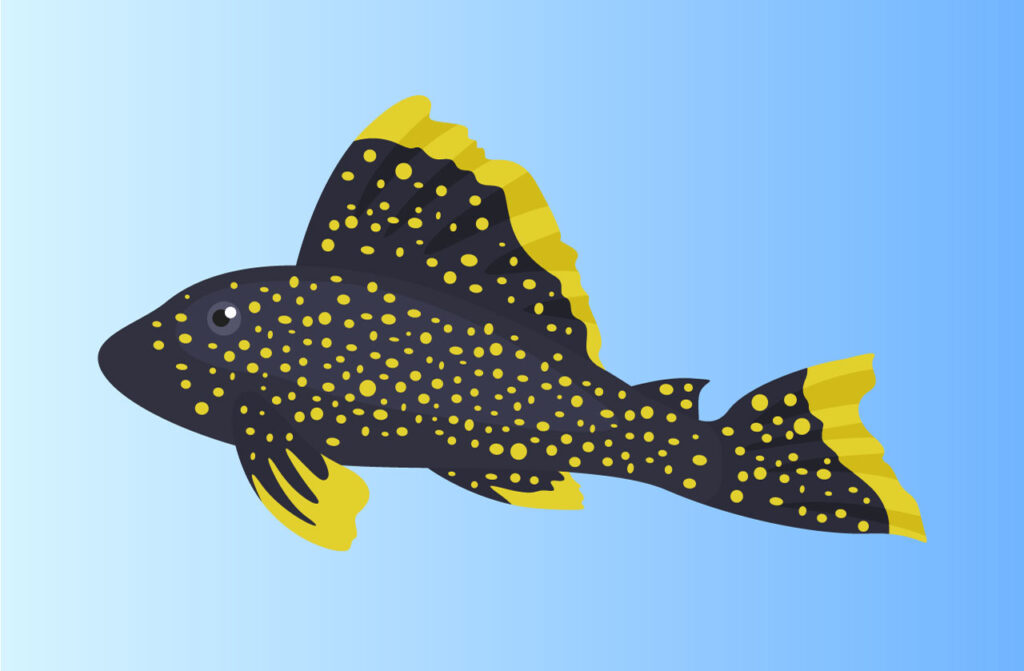
These fish are speckled with bright yellow dots. These dots pop on the black background, producing a stunning image. These Plecos are often peaceful and lonely. At night, they are more active. During the day, they’ll retreat to the tank’s bottom.
They may reach a maximum size of 10 inches (25 cm) in natural settings, but their development rate is significantly slowed to between 6 and 9 inches under aquarium conditions.
With proper care and illumination in the aquarium setting, the fish has been known to live up to seven years. A minimum tank size of 50 gallons is suggested for Golden Nugget Pleco. The Gold Nugget an algal-eating fish, also an omnivore. They will also require protein-rich snacks to maintain their health.
The Golden Nugget Pleco requires an aquarist to maintain a specific set of water conditions and parameters. In this case, the temperature of the water is between 23 and 26 degrees Celsius, and the acidity (pH) ranges from 6 to 7. A Golden Nugget Pleco can be infected with Ich, Fin Rot, Fish Fungus, Hole in the Head, and Pop Eye. Suggestions for tankmates for the Gold Nuggets are Honey Gourami, Apistogramma; Ember; and Sparkling Gourami.
The Royal Pleco (Panaque nigrolineatus) is one of the most significant freshwater fish species that may be kept in a freshwater aquarium. They often have a light grey base color with dark striped patterns. These lines are lateral. There are some markings on their pectoral fins. Typically, the dorsal fin is gold in color. Additionally, depending on the variety, it may be dark brown or black.
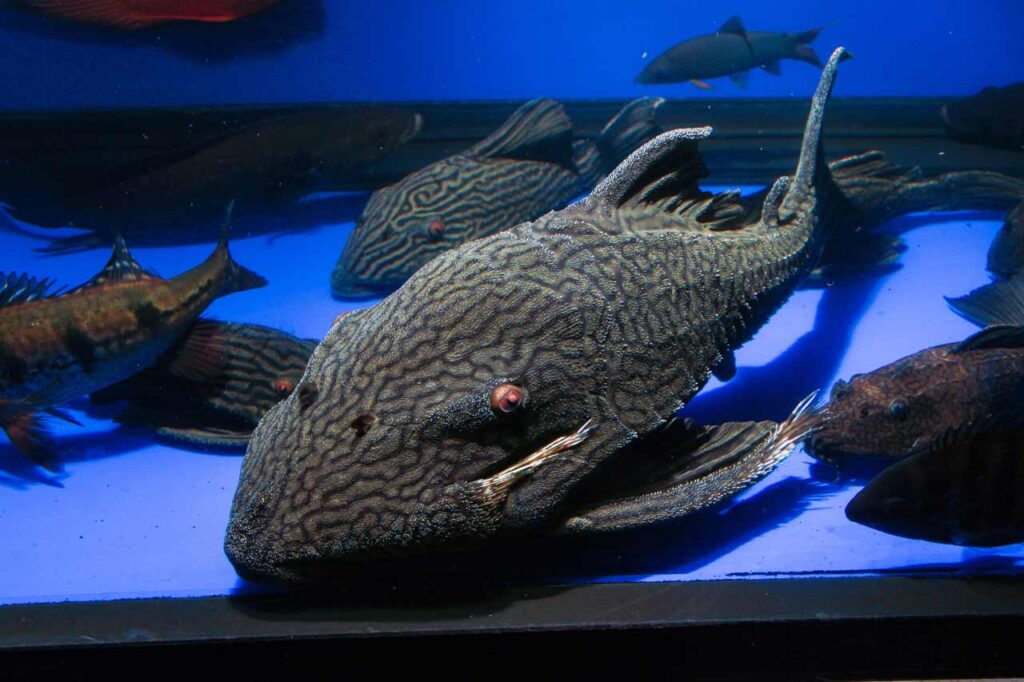
The most distinguishing characteristic of their heads is their enormous, bulbous crimson eyes. They will choose a favorite place and stay there. The fish may be aggressive, although they are normally timid. The typical Royal Pleco is 16-17 inches long when completely grown. A Royal Pleco may live for ten years with proper care and living circumstances. It requires a minimum of 30 gallons of water per fish, as well as lots of rocks and driftwood for grazing.
Due to the Royal Pleco’s origins in tropical seas, its aquarium must adhere to these restrictions. Temperatures should range from 72 to 78 degrees Fahrenheit (22-26 degrees Celsius), a pH of around 5 or 6, and dH of up to 10. The Royal Pleco is an omnivore, which means it will consume both meat and plant stuff.
Royal Plecos are also susceptible to bacterial illnesses like ICH, fin rot, and others. Due to their lack of scales, they are susceptible to copper. For tank mates, non-aggressive types of fish that come from the same region are often a suitable choice. Some of them are the Congo Tetra, Silver, Dollar Fish, Black Skirt Tetra, and Jaguar Cichlid. Royal Plecos breeding is a demanding endeavor. Breeding success is relatively uncommon for these fish.
Sailfin Pleco (Pterygoplichthys gibbiceps) is a vast freshwater catfish native to northern South America. Sailfin Plecos are non-aggressive and gentle. The dorsal fins of Sailfin Plecos are massive.
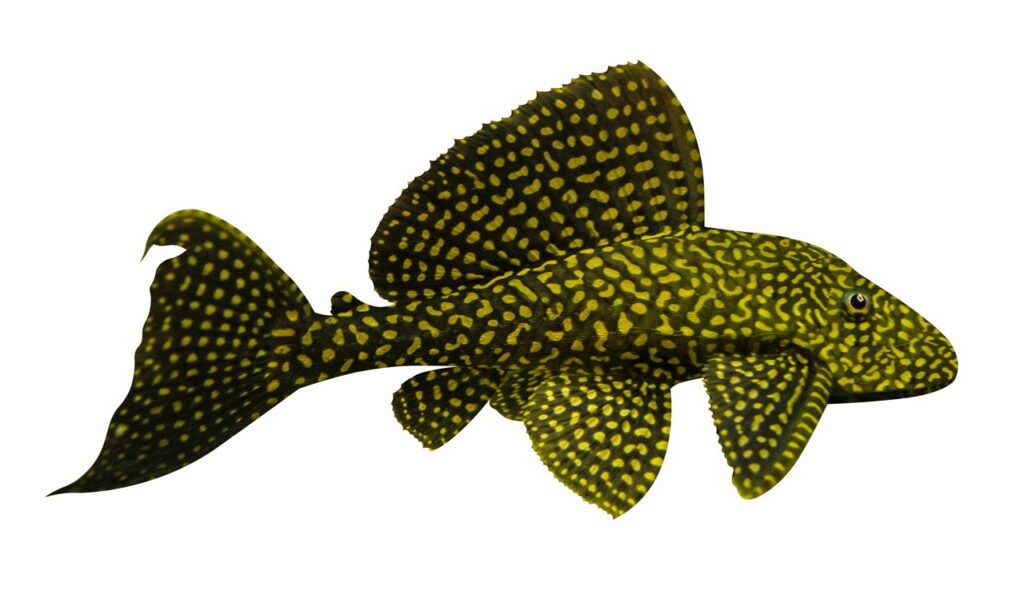
Plecos with large dorsal fins are called Sailfin Plecos. Whenever the dorsal fin is erect, it is quite high and covers a greater surface area. Even with the fin lowered, it extends almost to the caudal peduncle. Its body coloring is lovely. They are covered in a thick pattern of dots. When the beads are juxtaposed against a lighter base color, a cool leopard-like appearance is created.
Sailfin Pleco may reach a maximum size of 19 inches when kept in appropriate tank conditions and appropriately fed. A Sailfin Pleco’s usual lifetime in captivity is between 15 and 20 years. A tank of at least 100 gallons is suggested for Sailfin Plecos. Sailfin Plecos need water temperatures between 73 and 85 ℉ (22 and 29 ° C). The ideal pH range is between 6.5 and 7.5, and the ideal hardness is between 6 and 10 dKH.
Ich is the most frequent illness affecting Sailfin Plecos. In addition, skin and fill flukes, fungus, and bacteria may all cause disease as well. Sailfin Pleco is an omnivorous bottom feeder that will consume almost anything. The fish will like every form of food, from algae to vegetables and live meals. Congo Tetra, Black Skirt Tetra, Bloodfin Tetra, and Honey Gourami are all excellent tank mates for the Sailfin Pleco.
Snowball Pleco (Hypancistrus inspector) is a tiny, gentle Pleco well-suited for communal fish tanks. Snowball Plecos are speckled with white or yellow dots. Typically, the base color is black, gray, or reddish-brown. These dots are distributed more randomly and have an irregular shape, making them simple to distinguish from other species.
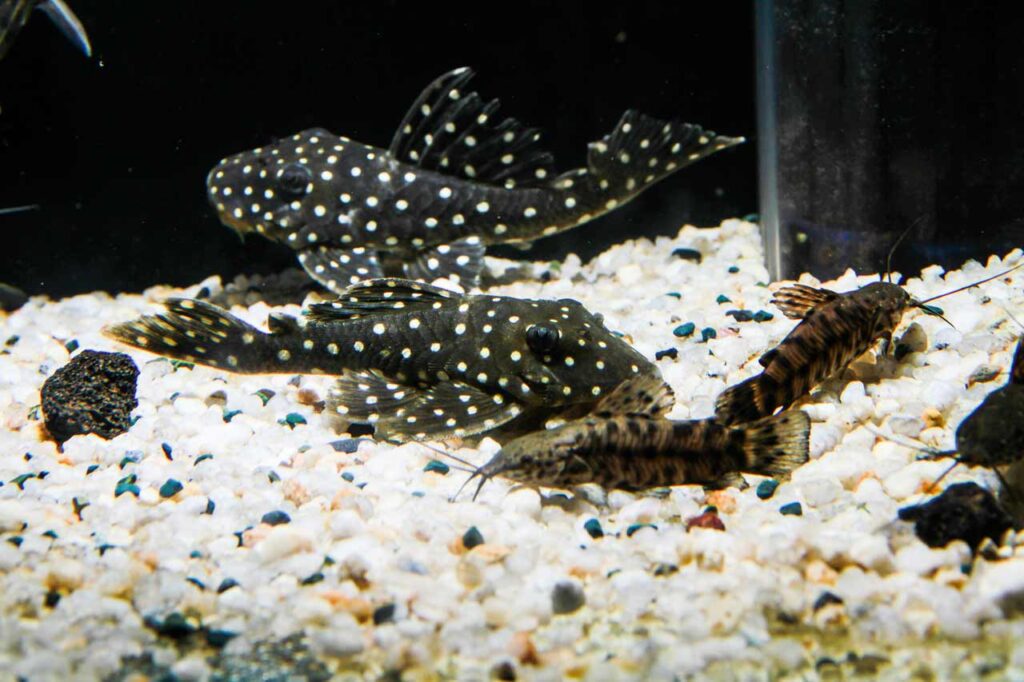
When fully developed, the Snowball Pleco is between 5.5 and 6.3 inches in length. A healthy Snowball Pleco has a lifetime of between 8 and 10 years. These fish thrive in aquariums as little as 40 gallons. To maintain your Snowball Pleco healthy, keep the water temperature between 72°F and 86°F, the pH level between 5.0 and 7.6 (anywhere in the center is optimal), and the hardness level between 6 and 10 dKH.
Snowball Plecos are omnivores by nature. It is recommended to provide a varied diet comprising wafers, pellets, flakes, and frozen food. They consume a small number of algae.
Ich is the most often seen illness in Snowball Pleco. Some suitable tank mates for the Snowball Pleco are numerous tetra species (particularly the Ember and Rummy Nose), Celestial Pearl Danio Discus , Corydoras, Apistogramma. Snowball Plecos are suitable for beginners but not for breeding. Snowball Plecos need a lot of care and a separate tank to reproduce in captivity.
Rubber lip plecos (Chaetostoma milesi) are South American freshwater fish. Rubber lipped Pleco and Rubbernose Pleco are other names for this fish. Rubber Lip Plecos are similar to typical Plecos, with a wide sucker mouth and snout, eyes towards the top of their heads, and a tapering body.
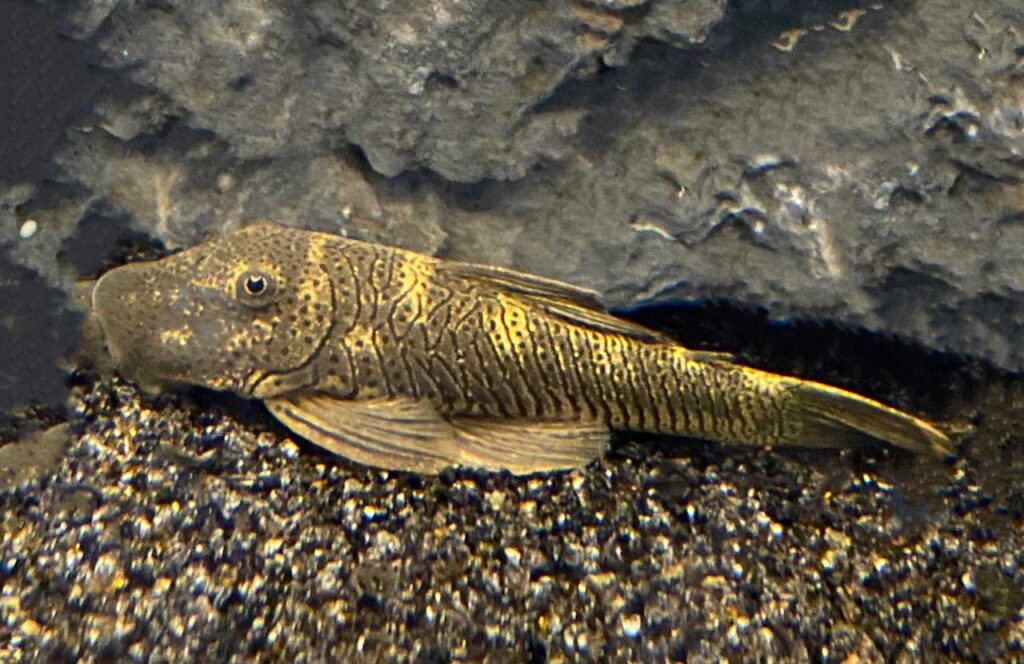
They usually are grey with dots on their faces and stripes on their bottom halves. The usual lifetime of a rubber lip Pleco is roughly 10-12 years with proper maintenance. The rubber lip Pleco’s maximum length is often approximately 7 inches. 25-30 gallons is the ideal tank size for one rubber lip Pleco. These fish’s preferred foods and diets include algae flakes or wafers, leafy greens, cucumbers, and peas.
Rubber lipped Plecos need very owner-friendly water conditions. Water temperature should be between 72 °F and 80 °F, pH should be between 6.5 and 8, and Water hardness: between 8 and 12 KH. Ich and other bacterial illnesses are all causes of concern. A few suggestions for tank mates that will work nicely, Green neon tetras, honey gouramis, and sparkling gouramis.
The Plecos (Peckoltia compta) is one of the most popular freshwater fish among aquarists. Some are Imperial Tiger Pleco L134. The fish is pretty lovely. It has alternating black and yellow stripes. Its head is enormous, and its pectoral and anal fins are prominent.
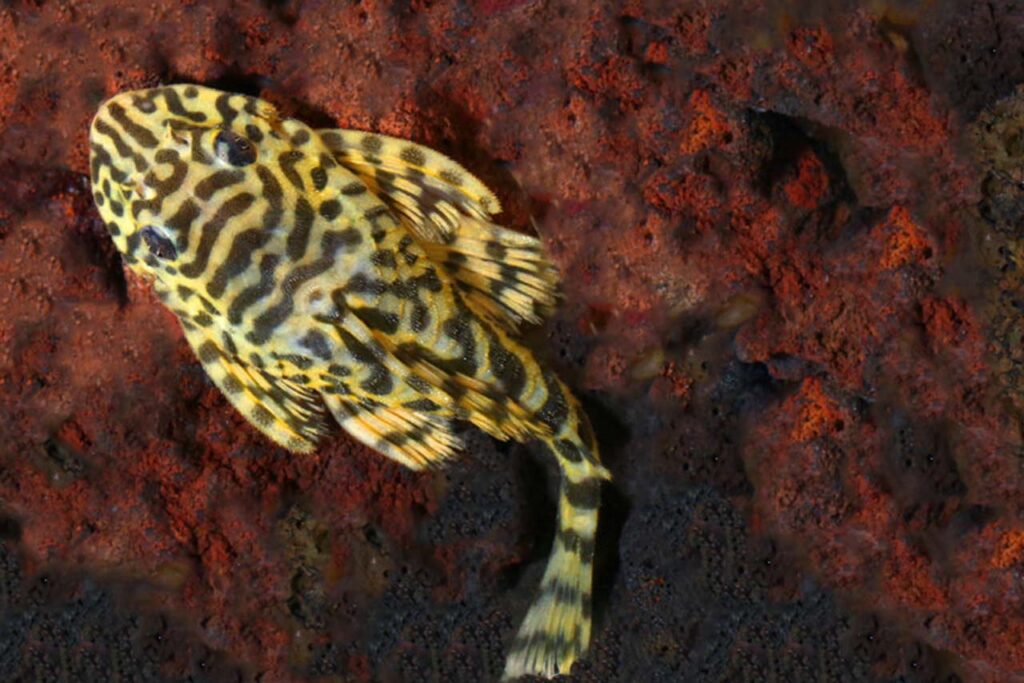
The Leopard Frog Pleco is mostly nocturnal but is relatively peaceful during the day. They become genuinely active when the lights are turned out. It has an average lifetime of between 8 and 10 years. Their usual length range is between 3.5 and 4.3 inches. Water temperature between 75 and 86 °F, pH values between 6.5 and 7.5, and water hardness between 6 and 10 dKH are ideal for Leopard Frog Plecos.
These fish are omnivores, eating a wide variety of foods. They want a 50/50 split between vegetables and protein in their diet. They like a lot of greenery and are also okay with Mysis, blood worms, Rapashi, and similar creatures. Apistogramma, Ember Tetra, Serpae Tetra are all fish suitable tank mates for this species. Ich, fin, dropsy are some of the most prevalent diseases the Leopard Frog Pleco may get.
The Peppermint Plecostomus (Parancistrus nudiventris) is a stunning pleco that ranges from dark brown to black. It originates in the wilds of Brazil. They are an excellent complement to any serene freshwater community aquarium. The Peppermint Plecostomus is often known as (L031) or (L-31).
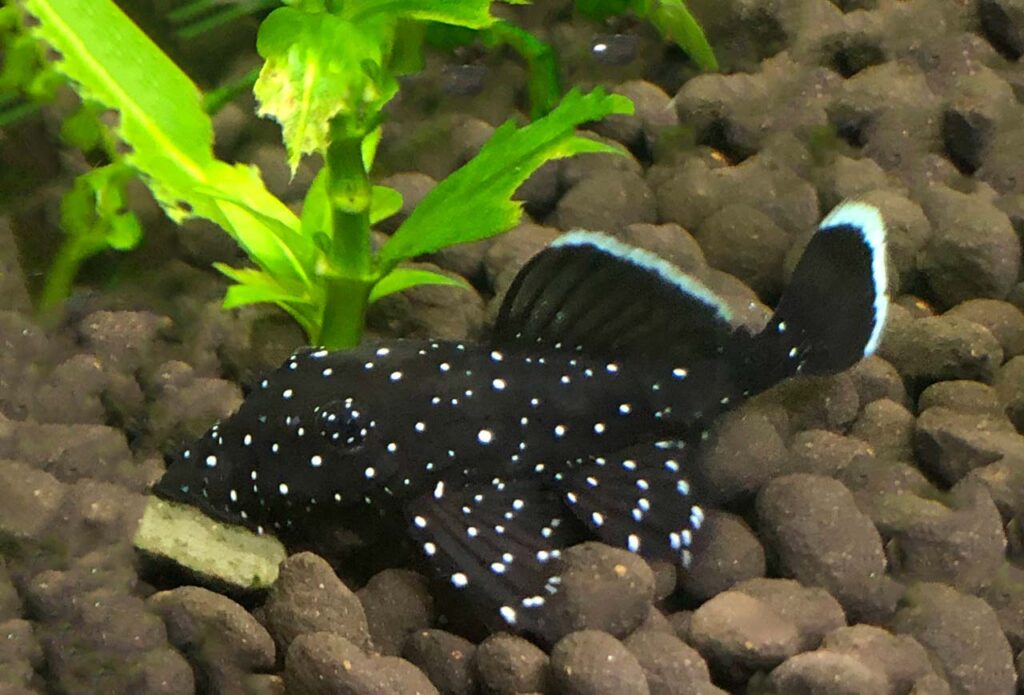
Aquariums with a high level of aeration and water movement are ideal for Peppermint Plecostomus to thrive. The addition of rocks and driftwood enhances the natural environment and provides hiding places for the Peppermint Plecostomus, reducing stress. A tank with a capacity of at least 50 gallons is required for this species. It is usually 7 inches in length. pH 6.5 – 7.5 and temperature 78-85F are the ideal water parameters for Peppermint Plecostomus.
The Pepperment Plecostomus has not yet been bred in an aquarium. Peppermint Plecos are not difficult to feed. Aquarists may provide them a lot of the leftover food in the tank since they are not very fussy about what they consume. As a “treat,” they should be fed various foods, including sinking pellets for herbivores, a high-quality flake, freeze-dried bloodworms, tubifex, brine shrimp, etc.
The Candy Striped Plecostomus (Peckoltia Vittata) is nocturnal and shy. So it will hide during the day and be active at night. An appropriate habitat should include enough driftwood for chewing and eating, a substrate of medium to big rocks, low lighting, hiding places, and good aeration and circulation. They originate from the Amazon River’s middle and lower reaches of South America.
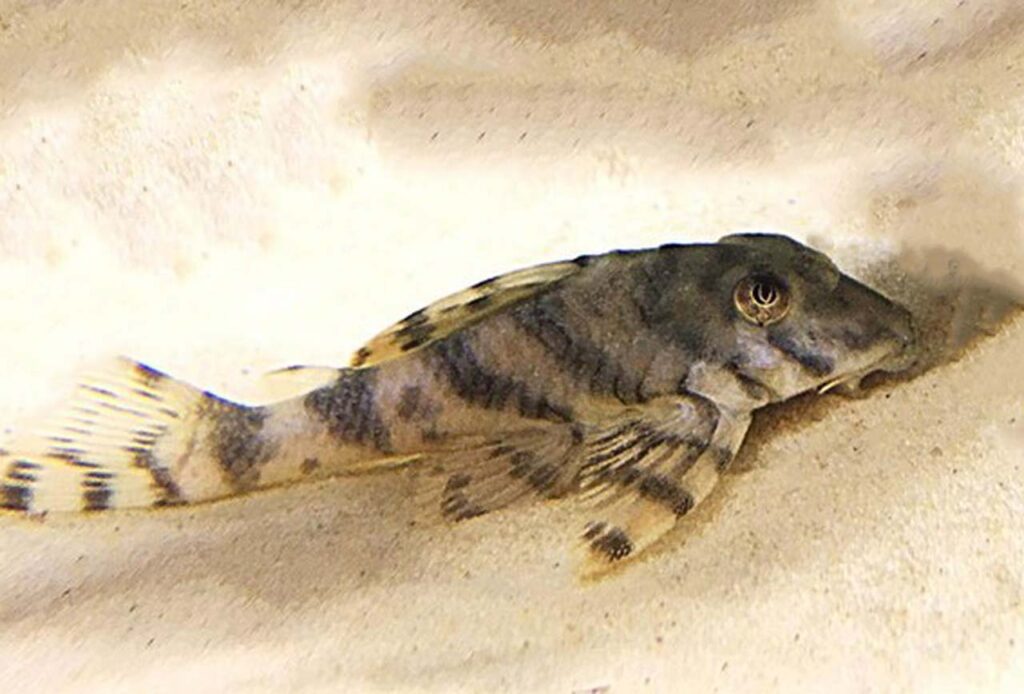
4 inches / 10 cm is the average length of an adult fish. For them, the recommended minimum aquarium size is 20 gallons / 80 liters. 73–79 °F / 23–26 °C is the ideal temperature for them.
They are omnivores that love meaty foods. Bloodworm, vitamin-rich brineshrimp, Mysis shrimp, and chopped prawns should be devoured, with occasional vegetable stuff such as courgette, cucumber, lettuce, squash, spinach, sweet potato, etc. In the home tank, Candy Stripe Plecs have been successfully bred. Due to their uncomplicated nature, Candy Stripe Plecs pair well with a wide variety of tankmates. Perfectly safe to keep with little fish and shrimp or sturdy enough to endure the attention of any but the biggest cichlids.
Plecos Vampires (Leporacanthicus cf. galaxias) are beautiful freshwater fish. Their low-maintenance care and aesthetic appeal set them apart. They are native to Colombia’s Orinoco drainage system. They have a flat bottom, an underturned mouth for eating algae, and long fins. The dorsal fin is long and rayed and normally flat on the back. It may lift the fin to swim in strong currents. Pectoral and pelvic fins feature delicate rays as well.
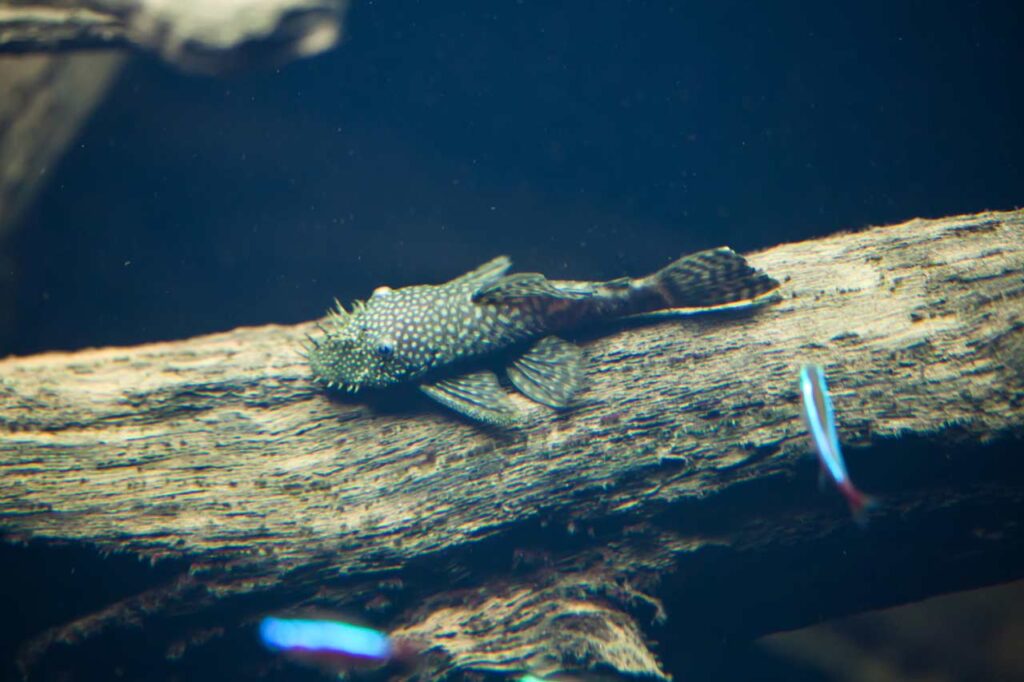
Most Vampire Plecos are dark black in hue. Some are dark or gray. Bodies have white and golden spots. The dots cover the fins as well as the upper body. A full-grown Vampire pleco is around 10 inches long. When properly cared for, Vampire Plecos may live up to 15 years. A single adult should have a 50-gallon tank. Ideally, water should be 72°F to 82°F (about 76°-78°C) with a pH range of 5.6-7.0 (slight acidity is preferable) and hardness ranging from 8 to 12 KH for vampire pleco.
Vampire Plecos are susceptible to the same illnesses as other freshwater tropical fish. The most prevalent diseases that affect plecos are ich and fungal infections. Black Skirt Tetras, Neon Tetras, Red Eye Tetras, Angelfish, and Silver Dollar Fish are all excellent tank mates for the Vampire Pleco. Breeding Vampire Plecos in captivity is challenging due to the difficulty of creating spawning conditions.
The gorgeous Sunshine Pleco (Scobinancistrus aureatus) is native to the middle and lower Ro Xingu. It is a nocturnal creature. As a result, it will remain hidden throughout the day and become active at night.
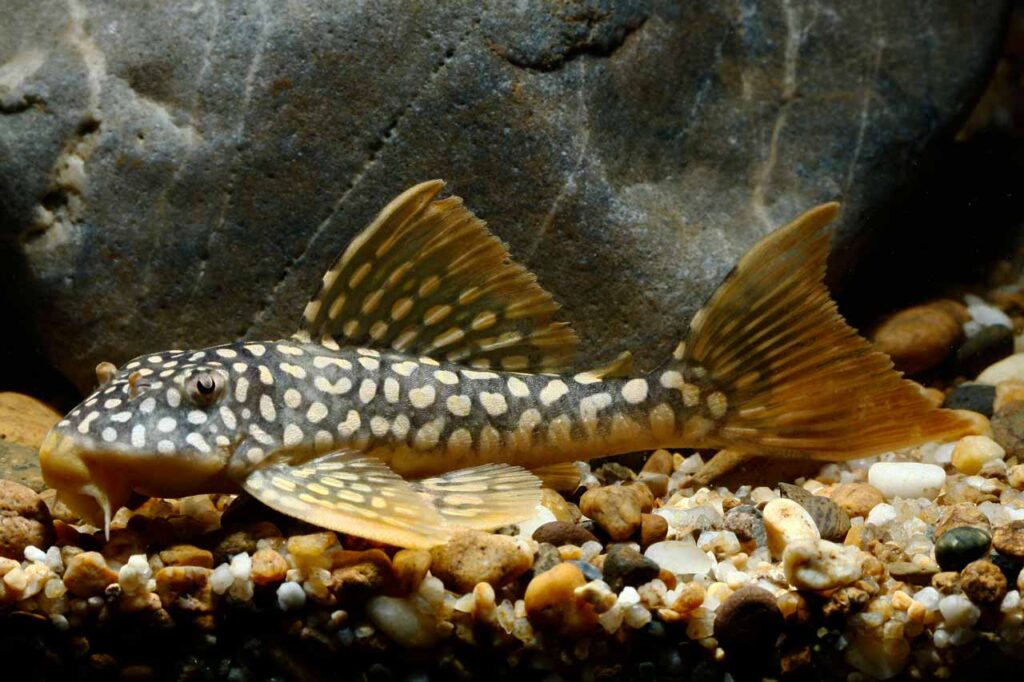
Their typical size in fish tanks is between 20 and 25 cm (7.87 – 9.84 inches). Life expectancy is estimated to be between 8 and 10 years. The Sunshine Pleco is Omnivorous; its teeth are visible. They need a minimum tank capacity of 125 gallons. A meaty diet consisting of blood worms, shrimp, and tubifex should be provided. It will also eat algal wafers and vegetable debris as a treat, but not as its primary diet. Additionally, it will feed on the algae that cover the tank plants.
The blue-eyed pleco (Panaque suttoni) is a South American species. They enjoy streams with vegetation and fallen branches, as well as a strong current of water. They have blue eyes and blue-tinged bodies. They are typically 35 – 45 cm in length in fish tanks (13.78 – 17.72 inches). An average lifetime of between 15 and 20 years of age may be expected if the Blue-eyed pleco is cared for properly. Their minimum tank size should be 120 gallons (480 ltr) incapacity.
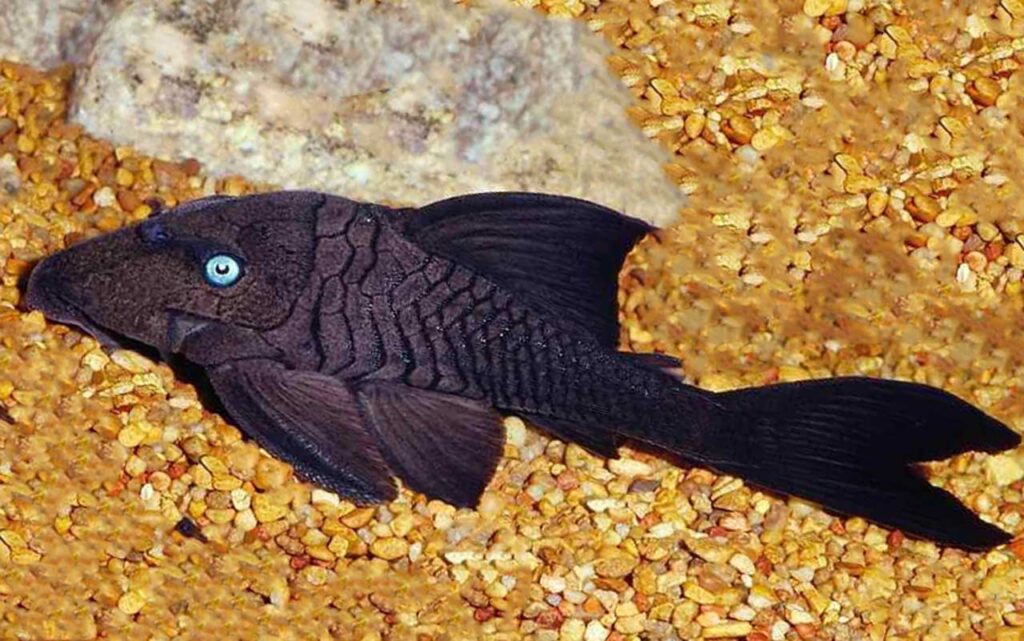
They are active at night and will need some swimming area in the lower levels of the aquarium. Bogwood will also help them digest. As an omnivore, the Blue-eyed pleco needs both plant and animal sources in its diet. This should be supplemented with live or frozen items such as blood worms, minced mussels, shrimp, or brine shrimp. Cucumber, zucchini, or blanched peas may be added for extra vegetable content. The species’ recommended pH range is 6 – 7, its recommended water hardness (dGH) range is 2 – 12°N (35.71 – 214.29ppm), and its recommended temperature range is 21 – 24 °C (69.8 – 75.2°F).
hey are calm fish that like to live at the aquarium’s lowest levels, but if more than one specimen is maintained, they might get territorial with one another. Although there are no accurate reports of blue-eyed plecos reproducing in aquariums, it is thought that they are cave spawners, which means they dig a cave in the river banks and spawn there.
Plecostomus butterfly (L168) (Dekeyseria brachyuran, Ancistrus brachyurus, Peckoltia pulcher) is a small pleco with an unusual design. It has a remarkable ability to camouflage in with its environment. They are timid fish that may exhibit increased activity throughout the night.
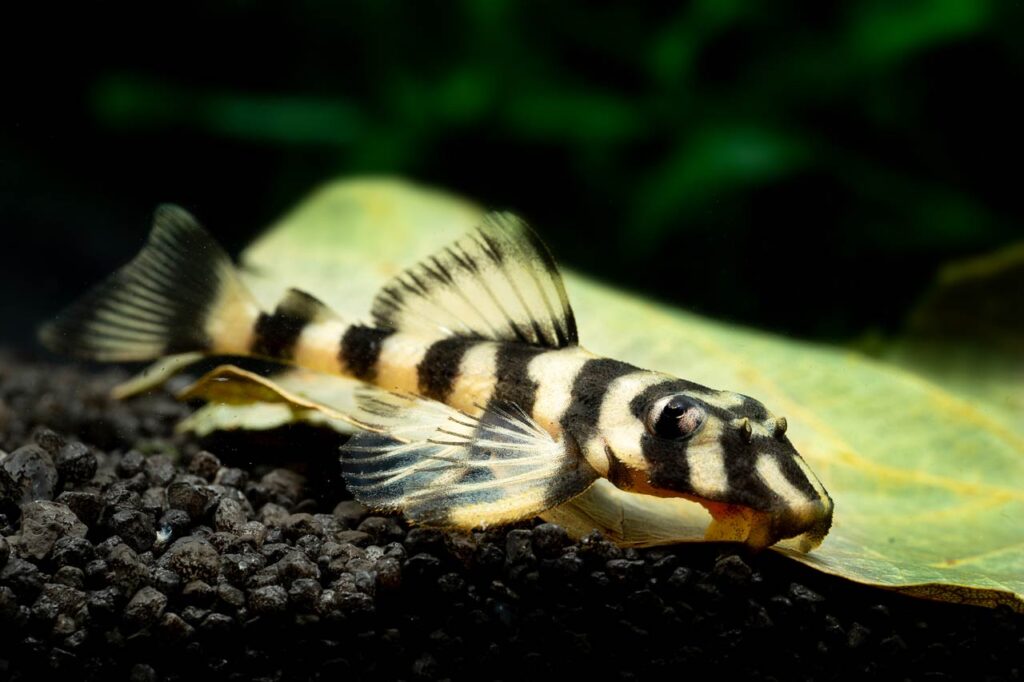
Butterfly Plecos grow to be roughly 6 inches in length. Butterfly Plecos need a clean, well-aerated environment to grow. They are often sighted feeding on the bottoms of fast-moving streams. Butterfly Plecos eat a wide range of plant materials. They are primarily herbivorous, eating algae, algal wafers, spirulina pills, and other vegetative debris. Cucumbers, Zucchini, blanched spinach, and blanched romaine lettuce are all veggies that Butterfly Plecos may be given.
Butterfly Plecos have a 5-year life expectancy. Certain individuals will live longer than seven years if maintained in a clean atmosphere and fed nutritious food. The pit is a quiet communal tank fish that should be housed with like this sized peaceful fish. Butterfly Plecos are cave-dwelling or cave-like animals. Numerous other Pleco species have this breeding habit, which is referred to as cave-spawning.
Plecos detest highly lighted regions and prefer to remain in shady portions of the tank or behind décor until the lights are turned off at night. These fish create a lot of waste and require a high-quality canister or HOB filter with replacement material to keep their water clean. An air stone is strongly advised to keep the oxygen content in your water at a healthy level.
Due to plecos’ enormous appetites and high waste production, pollutants rapidly accumulate in their water. Even with a well-maintained filtration system and new filter media, extreme care must be taken with water care.
Avoid overcrowding; it is a significant source of stress and sickness.
Ascertain that the feed is adequate for the type and enough hiding places are supplied in the tank.